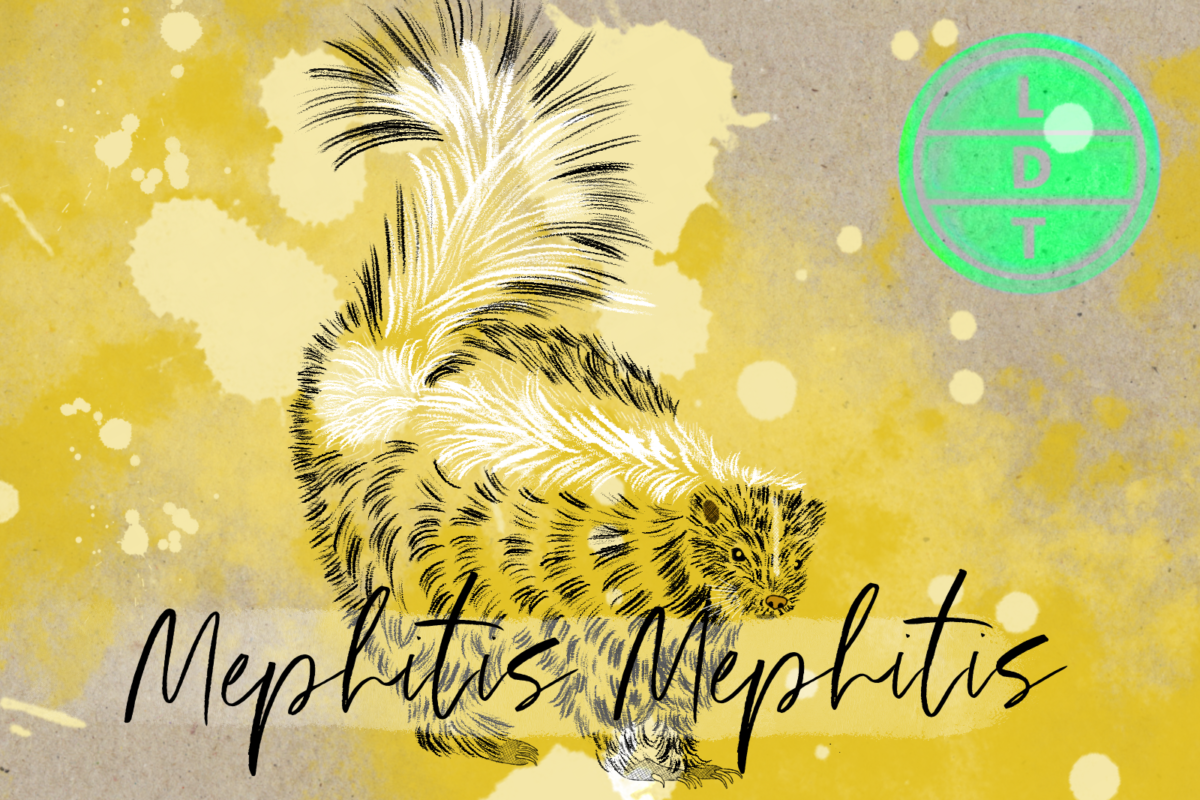“…and today we’re talking about a little guy that is as stinky as he is striped. But more on that later.”
Perhaps one of the world’s most famous (or infamous) animals is the humble skunk. But it’s not only famous in the human world, it’s also well-known in the animal kingdom. For animals that live near a skunk, seeing that flash of black and white fur stokes a primal fear of being stinky. But how stinky is it? And why does it smell like a burning tire at Coachella? It’s all part of letting potential predators know who’s boss here in Life, Death, and Taxonomy.
Description of the Striped Skunk
- The skunk is a stout carnivore shaped animal with short legs, a stocky body, and a big bushy tail.
- It has a head shape befitting the subfamily Musteloidea, with a cone-shaped skull and powerful jaws.
- It walks on the full foot of its forepaws and has five long claws like a bear.
- Striped skunks are black and white. They are mostly black with a white back and a black stripe running down their back. They differ from their kin, the hooded skunk that does not have the black center stripe.
Measure Up
Welcome to the beloved Measure Up segment. The official listener’s favorite part of the show! The part of the show when we present the animal’s size and dimension in relatable terms through a quiz that’s fun for the whole family. It’s also the part of the show that’s introduced by you when you send in audio of yourself saying, singing, or chittering the words Measure Up into ldtaxonomy at gmail dot com. We do have a new Measure Up intro from Nora!
We also have listener mail from Bron!
Body length
- 52 and 77 cm (30.3 inches)
- How many Stink Blasters toys go into the length of a striped skunk?
- Hint: Stink Blasters was a line of children’s toys that were popular in the early 2000s. The toys were plastic figurines of boys wearing grunge style clothing. Three series of toys were created but only two were officially released. You could collect individuals named Barfin’ Ben, Tony Anchovy, and Skunk Punk. When the plastic toys were squeezed, they would emit a foul smell. The toys contained toxic cyclohexanone and toluene, though the levels were low enough to be safe.
- 10.1 Stink Blasters. The toys were 3 inches tall.
Weight
- 1.8–4.5 kg (4.0–9.9 lb)
- How many striped skunks go into the amount of Stinking Bishop cheese that is produced each year?
- Hint: Stinking Bishop cheese is a cheese made from the milk of Gloucester breed cattle by Charles Martell and Sons in Gloucestershire, England. It gained international notoriety when Gromit used the cheese to revive an incapacitated Wallace in Wallace and Gromit: The Curse of the Were-Rabit.
- 4,453.7 skunks. 20 tonnes (44,092.5 lbs) are produced annually.
Fast Facts About the Striped Skunk
Striped skunks live in North America and may be found as far north as central Canada close to the arctic circle and as far south as Mexico.
They can live in a variety of habitats, including woodlands, open fields, rocky ravines, and scrublands.
Skunks mostly eat insects, especially grasshoppers, crickets, beetles, and bees. They may also eat crayfish, worms, and other arthropods. When it gets esparate in the winter, it may eat vertebrates like mice, bird chicks, reptiles, frogs, fish, and voles. They may also supplement their diets with berries, corn, and nightshades.
Skunks don’t have many natural predators, but birds of prey may kill and eat them if they are skilled enough. Mammals, like coyotes, bobcats, foxes, and badgers, avoid them unless they are extremely hungry.
Skunks mate once per year in the spring. Males will travel 4 km (2.5 miles) each night looking for a mate. Litters of 2 to 12 kits are born in a den that was dug or taken over by their mothers. Mothers and kits will spend the winter in their den. When they emerge in the spring, young skunks will hang out with their mom until they strike out on their own three months later.
In some cases, multiple females and a single male will share a den to get out of the cold. They may come out and look for food during the winter, they will mostly rely on body fat reserves to make it through to spring.
Major Fact: The Stinkiest Gun in the West
This gross cat is well-known for having a smelly tuchas. There are two anal glands located…well, you know where they’re located. When the skunk is threatened, it lifts its tail and releases a spray from these glands that violates the Geneva convention.
The spray is made up of chemicals called thiols (sulfur and hydrogen combos), something pretty prominent in rotten flesh and poop, so most mammals’ natural instinct is to get as far as possible and it can even immediately induce vomiting.
Can reach up to 20 feet – the smell can be smelled from up to a mile. Females will spray males they’re not into. Males will spray each other over territory.
Causes irritation and temporary blindness if it gets into the eyes.
Tomato juice doesn’t actually work. You need hydrogen peroxide, baking soda, and soap. That’s also how you make a very clean science fair volcano.
This is a genius self-defense mechanism because the predator isn’t killed or maimed, it’s taught. Now that coyote or cat or hawk will sit its children on its knee and tell them the story of how they received a face full of anus juice that one time they tried to eat a black and white stripey thingy. So the striking coloration, which doesn’t do much for camouflage, serves as a bright warning of impending stank.
Ending: So stay outta harm’s way, earn your stripes, and use your glands to the best of your ability like the striped skunk here in LDT.

